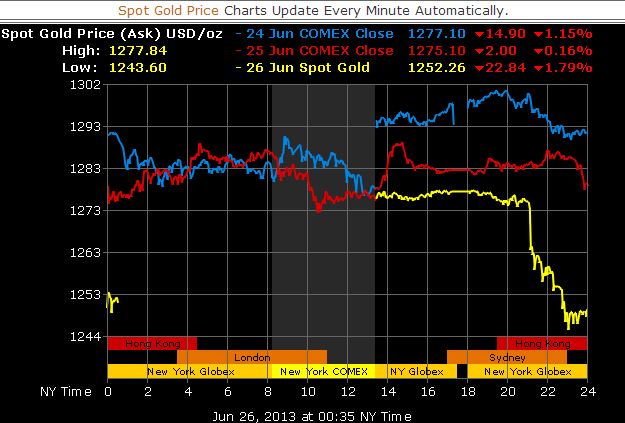Spot gold prices sank to a three-year low of $1,222.70 in after-hours trade today, June 26, 2013, after yesterday's positive data from the US pointed to an early end to the US Federal Reserve’s quantitative easing programme.
Global gold price was down over $50 per ounce in today's session, and was trading at $1,223.63 per ounce at 10.50pm UAE time (6.50GMT) with a further downward bias.
Consumer confidence in the US came at a five-year-high, and house prices in the country saw their biggest jump in seven years, signaling a an eventual revival of the economy and, therefore, and end to the Fed’s fiscal stimulus.
A number of international banking giants, the latest being HSBC, have been eagerly cutting gold price forecasts in the face of a tapering of the QE3 program.

Credit: GoldPrice.org
In fact, there have been recent reports of some noted analysts claiming that gold, a safe haven precious metal, could decline to pre-QE levels.
In a report published late Monday, an HSBC analyst said the bank sees gold trade between $1,125 and $1,375 for the remainder of 2013, suggesting that prices could still go lower by another 10 per cent this year.
Gold has already lost almost a quarter of its value in the first six months of 2013, and has slumped a massive 35 per cent from its all-time high of $1,920/oz hit in September 2011.
HSBC yesterday slashed its outlook on the metal’s price prospects, citing the US Federal Reserve’s plan to stop pumping the global economy with $85 billion worth of freshly minted dollars every month.
Once the US Fed gets on the path of scaling down (most economists expect it to start the process by September this year), the dollar will gain further strength while emerging market assets, as well as global commodities and precious metals, are expected to bear the full frontal force of drying up liquidity.
In November 2008, just after the infamous collapse of investment bank Lehman Brothers, and before the start of the Fed’s stimulus program, gold price touched a low of $709.50 on November 12, 2008.
The metal, however, rose to its lifetime high of $1,920 per troy ounce in less than three years, on September 6, 2011, as the US Federal
Reserve flushed the world with fresh dollars to jumpstart the global economic engine.
Now, however, with that well soon to run dry, investors are pulling their investments out of asset classes that benefitted the most from the stimulus, and that includes emerging market stocks, and precious metals.
HSBC shaved 9.5 per cent off its 2013 gold price forecast, and now expects the metal to average $1,396 a troy ounce this year. It cut its 2014 gold outlook 10.3 per cent to $1,435 an ounce and reduced its 2014 forecast by 11.4 per cent to $1,395 an ounce.
HSBC analyst James Steel maintained in his report that “[t]he discussion by the Fed of a tapering, or reduction, of its quantitative easing asset purchases was more aggressive than we initially envisaged, and has resulted in higher US Treasury yields, which are traditionally negative for gold.”
“Price-sensitive buyers may wait for a well-defined bottom before entering the market,” said Steel. “For the remainder of the year we forecast a $1,125 an ounce to $1,375 an ounce trading range for gold.”
HSBC’s downgrade is part of a larger trend that has seen other investment banking giants, including BNP Paribas, Credit Suisse, Goldman Sachs, Morgan Stanley and Standard Bank, all downgrade their outlook on gold prices.

![]() Follow Emirates 24|7 on Google News.
Follow Emirates 24|7 on Google News.